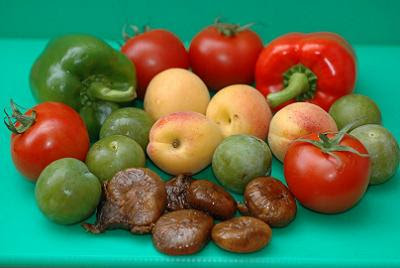This recipe and write-up is brought to you by my father, Mike. This isn't really Atlas Mountain Soup. According to my son, the word "soup" is not appropriate to this dish. The truth is that, when I came to cook the classic Moroccan dish I simply couldn't find a recipe. We used to have one in a cookbook but it seems to have gone walkabout - it's probably headed off back to the peace and tranquility of the High Atlas Mountains. And we couldn't find anything on the web, either. So this is my entirely invented dish of Atlas Mountain Stew, with a few comments on how it can be improved still further. Ingredients (4 portions) ½ kg minced lamb 6 tangerines (select tart fruits, don't use the over-sweet types) 3 tsps ras el hanout spice mixture 2 green bell peppers (I used one red and one green, but both green for added bitterness would be better) 1 large yellow onion 4 tomatoes 4 apricots 6 greengages (tart plums would be a good substitute) 6 figs (with hindsight I would have omitted this ingredient) 1 tsp mixed herbs (herbes de Provence works well in this) 2 bay leaves olive oil salt black pepper couscous, rice, bread or other carbohydrate base with which to serve the sauce. Method |
 | The first step is to make a marinade for the meat. Squeeze the tangerines, blitz the juice and pulp in a food processor and strain out the solid material using a strainer with large holes. |
| Using your (washed) hands, mix the minced lamb thoroughly with the tangerine juice, two teaspoons of the ras el hanout mixture and some salt and freshly ground black pepper to season. |  |
 | Translated as "head of the shop" in Arabic, the term ras el hanout refers to a mixture of the best spices a seller has to offer. These days the mixture is readily available in spice stores and larger supermarkets. Some mixtures can contain ingredients that are now illegal, so be sure to buy from a reputable source. |
| While the meat is marinating for a couple of hours, prepare the fruits (note that although we often refer to tomatoes and peppers as vegetables, they are both fruits). |  |
 | At this stage add the remaining teaspoon of spice mixture and some more boiling water and continue to cook for another 30-45 minutes. |








